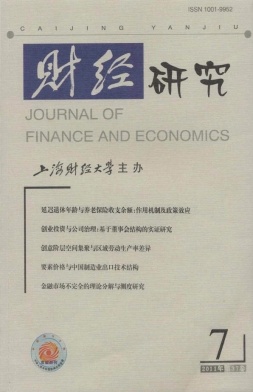抚养负担、居民健康与经济增长——影响我国县市经济发展的人口特征因素
财经研究 2011 年 第 37 卷第 07 期, 页码:18 - 28
摘要
参考文献
摘要
文章在扩展经济趋同理论研究框架的基础上,建立了抚养负担影响经济增长的可识别方程,并利用2000-2007年我国县级层面数据进行了实证检验,研究发现:老年和少儿抚养负担的加重对经济增长均有非常显著的负向影响,并且前者的影响更大;居民健康水平对经济增长有非常显著的正向影响;选择更为合理的衡量居民健康水平的指标对正确识别健康与抚养负担对经济增长的真实影响非常重要。文章指出,随着我国人口老龄化趋势的加快,伴随人口生育水平下降的少儿抚养负担的减轻和居民健康水平的改进可能仍不足以抵消老年抚养负担加重对经济增长的负向影响。
[1]林毅夫,刘培林.中国的经济发展战略与地区收入差距[J].经济研究,2003,(3):19-25.
[2]王德文,蔡昉,张学辉.人口转变的储蓄效应和增长效应——论中国增长可持续性的人口因素[J].人口研究,2004,(5):2-11.
[3]郑长德.中国各地区人口结构与储蓄率关系的实证研究[J].人口与经济,2007,(6):1-4.
[4]蒋云赟.我国人口结构变动对国民储蓄的影响的代际分析[J].经济科学,2009,(1):30-38.
[5]李文星,徐长生,艾春荣.中国人口年龄结构和居民消费:1989-2004[J].经济研究,2008,(7):118-129.
[6]张琼.基于韦伯与正态分布非线性估计的我国人口死亡年龄分布[J].保险研究,2010,(8):3-9.
[7]Bloom D,Williamson J.Demographic transitions and economic miracles in emergingAsia[J].World Bank Economic Review,1998,12(3):419-455.
[8]Mason A.Population change and economic development in East Asia:Challenges met,opportunities seized[M].Stanford,CA:Stanford University Press,2002.
[9]Leff N.Dependency rates and savings rate[J].American Economic Review,1969,59(5):886-896.
[10]Ram R.Dependency rates and aggregate savings:A new international cross-sectionstudy[J].American Economic Review,1982,72:537-544.
[11]Jongwanich J.The determinants of household and private savings in Thailand[J].Ap-plied Economics,2010,42(8):965-976.
[12]Aghion P,Howitt P,Murtin F.The relationship between health and growth:When Lu-cas meets Nelson-Phelps[R].NBER Working Paper,2010.
[13]Li H,Zhang J,Zhang J.Effects of longevity and dependency rates on saving andgrowth:Evidence from a panel of cross countries[J].Journal of Development Econom-ics,2007,84(1):138-154.
[14]Lorentzen P,McMillan J,Wacziarg R.Death and development[J].Journal of EconomicGrowth,2008,13(2):81-124.
①此数据来源的详细描述参见张琼(2010)。
[2]王德文,蔡昉,张学辉.人口转变的储蓄效应和增长效应——论中国增长可持续性的人口因素[J].人口研究,2004,(5):2-11.
[3]郑长德.中国各地区人口结构与储蓄率关系的实证研究[J].人口与经济,2007,(6):1-4.
[4]蒋云赟.我国人口结构变动对国民储蓄的影响的代际分析[J].经济科学,2009,(1):30-38.
[5]李文星,徐长生,艾春荣.中国人口年龄结构和居民消费:1989-2004[J].经济研究,2008,(7):118-129.
[6]张琼.基于韦伯与正态分布非线性估计的我国人口死亡年龄分布[J].保险研究,2010,(8):3-9.
[7]Bloom D,Williamson J.Demographic transitions and economic miracles in emergingAsia[J].World Bank Economic Review,1998,12(3):419-455.
[8]Mason A.Population change and economic development in East Asia:Challenges met,opportunities seized[M].Stanford,CA:Stanford University Press,2002.
[9]Leff N.Dependency rates and savings rate[J].American Economic Review,1969,59(5):886-896.
[10]Ram R.Dependency rates and aggregate savings:A new international cross-sectionstudy[J].American Economic Review,1982,72:537-544.
[11]Jongwanich J.The determinants of household and private savings in Thailand[J].Ap-plied Economics,2010,42(8):965-976.
[12]Aghion P,Howitt P,Murtin F.The relationship between health and growth:When Lu-cas meets Nelson-Phelps[R].NBER Working Paper,2010.
[13]Li H,Zhang J,Zhang J.Effects of longevity and dependency rates on saving andgrowth:Evidence from a panel of cross countries[J].Journal of Development Econom-ics,2007,84(1):138-154.
[14]Lorentzen P,McMillan J,Wacziarg R.Death and development[J].Journal of EconomicGrowth,2008,13(2):81-124.
①此数据来源的详细描述参见张琼(2010)。
引用本文
张琼, 白重恩. 抚养负担、居民健康与经济增长——影响我国县市经济发展的人口特征因素[J]. 财经研究, 2011, 37(7): 18–28.
导出参考文献,格式为:





 6550
6550  3093
3093

